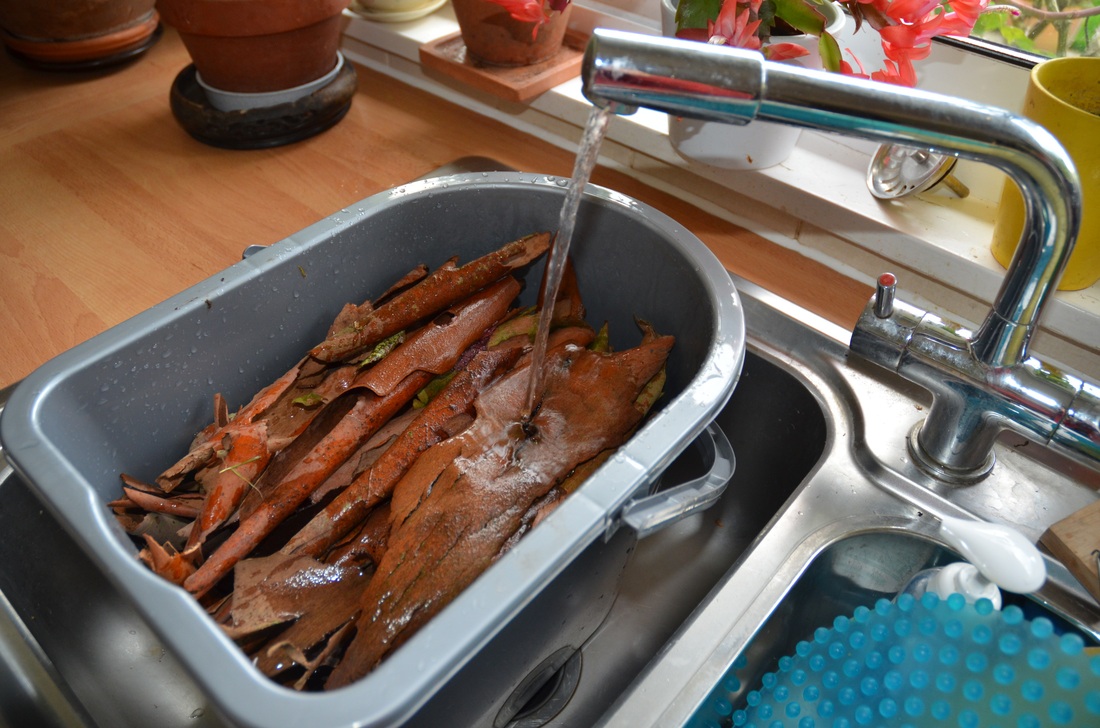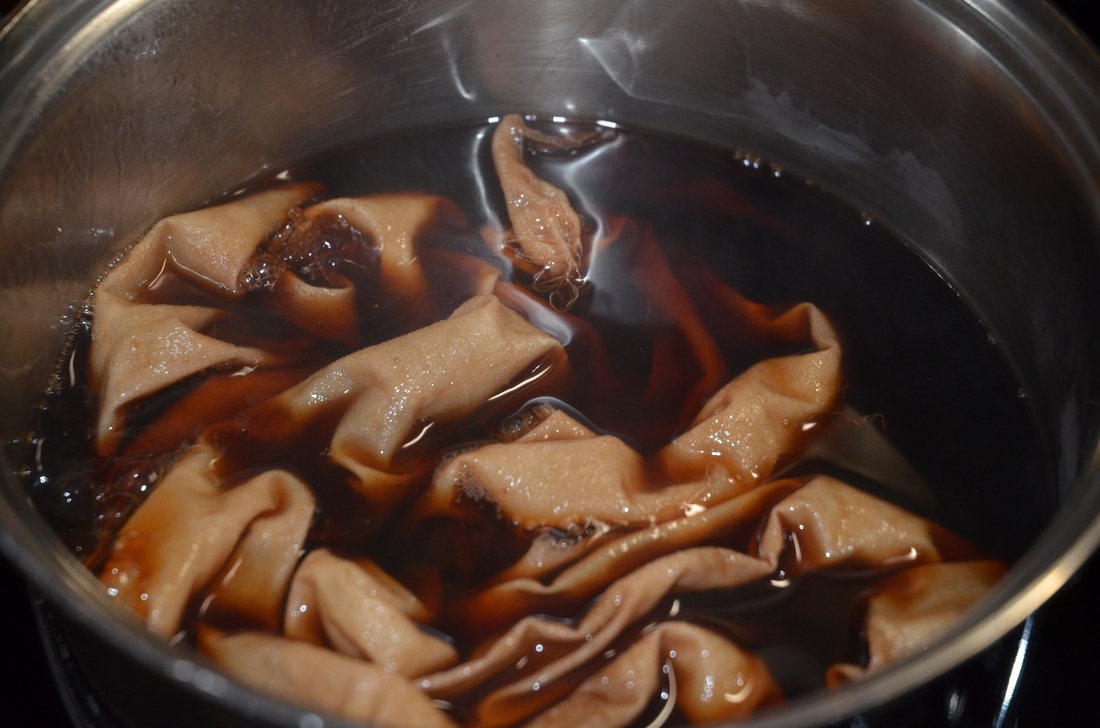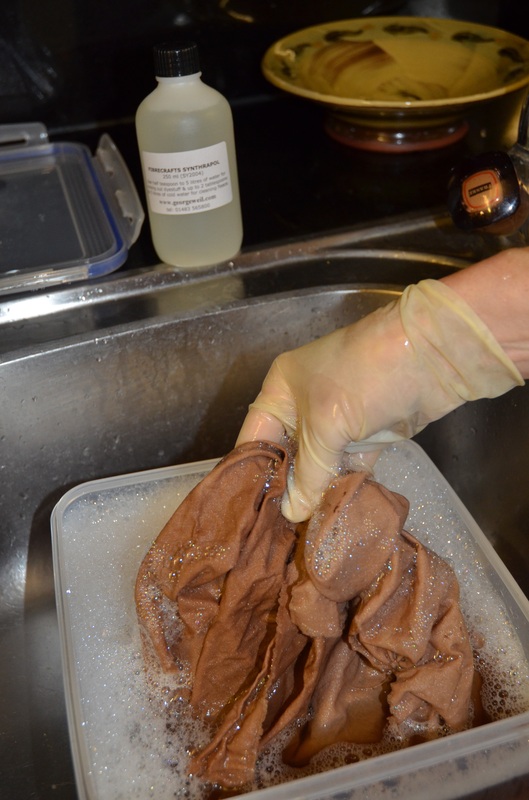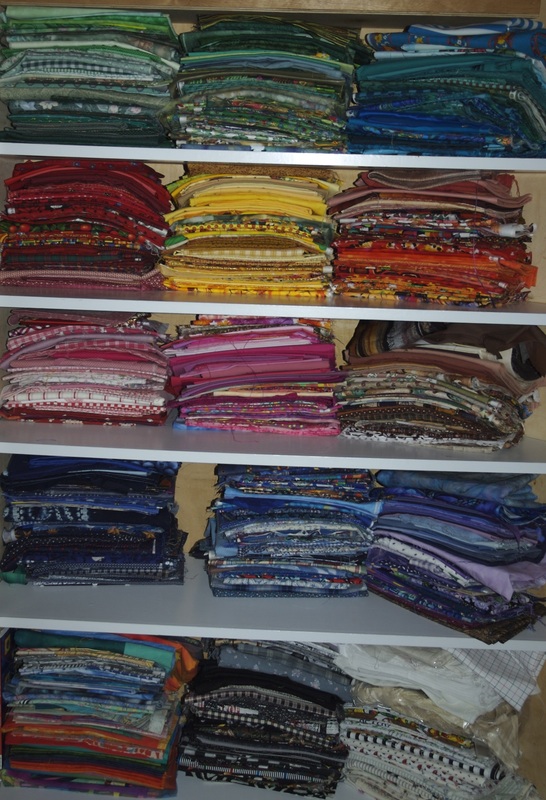|
While I was photographing Jack, I decided that those Japanese maple leaves would be one of my first natural dyestuffs, so I collected a very large amount in a stainless steel pot. I covered the leaves with water and soaked them for about an hour. I then simmered the leaves for about 5 hours (covered) and left everything to cool overnight. The next day I strained out the leaves, (put them on the compost heap) and poured the reddish-brown broth into a plastic container. For another dyestuff, I gathered Eucalyptus bark that had dropped on the ground all around a tree in my garden (never remove bark from a living tree, it goes without saying). I soaked the bark in warm water overnight (some natural dyers soak bark for much longer but I was too impatient), then boiled it for about 8 hours the next day—a lovely aroma permeated the house. I let the bark soak in the water for a couple of days, then poured that dark brown solution into a separate plastic container. In the meantime, while the leaves and bark were cooking and soaking, I scoured several fat quarters of my 100% cotton fabric in a hot machine wash to prepare them for dyeing, and soaked them in Synthrapol for a few minutes before rinsing them in warm water. I then added a mordant to the fabrics by simmering them in an alum acetate solution for an hour, then leaving them in the solution overnight. A mordant is a chemical agent that adheres to both fibers and dye, binding them together; the term is derived from the Latin mordere, which means “to bite”. The next day I divided the Japanese maple leaf broth into 2 stainless steel pots (never again to be used for cooking!). I added a tablespoon of salt to one pot, and then immersed one fat quarter of the mordanted fabric into each pot. I simmered the fabrics for one hour, not letting the solutions come to a boil. I removed the fabrics from the pots, rinsed them under running water and soaked them in Synthrapol. I repeated this process with the Eucalyptus solution. Next time I'll show you the dyed fabrics and how they were affected by the salt.
0 Comments
Greetings! I have been reading some wonderful blogs and news postings over the past few years and wondered whether I should add one of these to my website, now that it is officially up and running. I talked it over with my website/book designer, Jane Glennie, and she thought it was an excellent way to keep this website current and to keep you up-do-date on how things are progressing on the new book that I'm writing. So I'm going to post some information from time to time about about what's going on "behind-the-scenes" while researching material and techniques for this book. It will hopefully keep you entertained, and is definitely a great way to procrastinate from what I should actually be doing, which is writing the book itself! Anyway, at this point the book is probably about half finished. I am currently working on the Surface Design chapter, specifically on Natural Dyeing. I can't tell you how exciting it is to research all the different topics for this book, and how wonderful it is to be able to "play" while learning about each subject in depth. Natural Dyeing has opened my eyes not only to the wonderful substances that can be used to create beautifully coloured fabric, but it's also encouraged me to really observe the gorgeous colours all around me at the moment--colours that echo what can be achieved with natural dyeing. I think this is the most spectacular autumn I can remember since moving to England in 1984. When I took this picture of my Border Terrier, Jack, I decided that I had to try dyeing with Japanese maple leaves. So I've gathered up a huge amount of bright red leaves. Next time I'll show you the results!
PS. The photo at the top of this post shows a small selection of fabrics from my stash. Jane told me to put a photo at the top of each post to make it look more interesting and I always listen to her! |
Archives
March 2023
Categories
All
|






 RSS Feed
RSS Feed